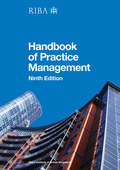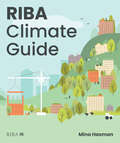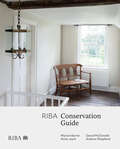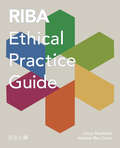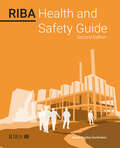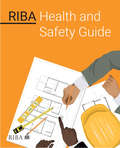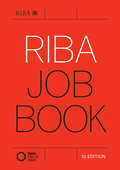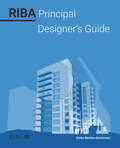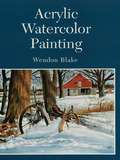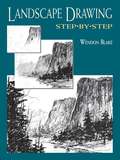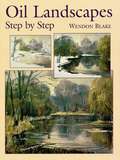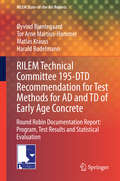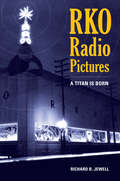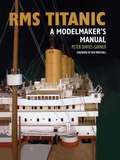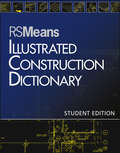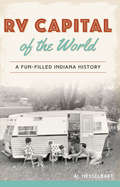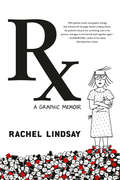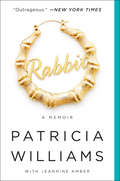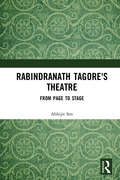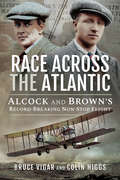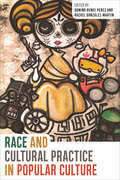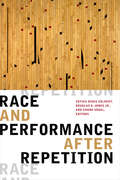- Table View
- List View
RIBA Architect's Handbook of Practice Management: 9th Edition
by Nigel OstimeThe professional architect’s business management bible now encompasses the RIBA Plan of Work 2013 to reflect the very latest practice in today’s cutting-edge architectural environment. With an emphasis on the practical aspects of working as an architect, the 9th edition combines clear and comprehensive guidance with a focus on new directions in practice management which will give a modern practice that vital commercial edge. Topics range from starting up a practice and developing a business strategy, to how to win clients, manage people, and handle fees. It includes new sections on topics such as knowledge management, QA, IT and project management too. With its clear, accessible layout, and no-nonsense style aimed at busy architects, this is a must-read for practices of all sizes and the ideal companion to the RIBA Job Book, 9th edition
RIBA Climate Guide
by Mina HasmanClimate change is a threat to humankind, which requires immediate action. The built environment has a vital role to play in responding to the climate emergency. There is a pressing need for architects to acquire the requisite skills and knowledge to design buildings that deliver sustainable outcomes, meeting the RIBA 2030 Climate Challenge and mandatory competence in climate literacy. Equipping you with the key information that built environment professionals require to halt climate change and mitigate its impacts in your day-to-day work, this book is organised around six overarching topics: 1. Human Factors 2.Circular Economy 3.Energy and Carbon 4.Water 5.Ecology and Biodiversity 6.Connectivity and Transport Featuring images and original illustrations, each themed section will guide you through fundamental elements and competencies for creating a sustainable design and delivery framework that can be implemented by you in your practice. Contextualising the climate emergency within the built environment landscape, the guide maps out the essential background knowledge around climate science, international agreements, legislations, commitments and roadmaps. A collection of short, building- and urban-scale case studies present key takeaways, illustrating real-life applications of design strategies and industry-wide tools, as well as standards that are deployed in climate-conscious built environments all around the world.
RIBA Conservation Guide
by Andrew Shepherd David McDonald Marion Barter Anna JoyntThis is an essential guide for those taking either the RIBA Conservation Register Course or another building conservation course. Taking as its starting point the ICOMOS Education and Training Guidelines, the internationally-recognised set of criteria, this book explores everything you need to know when undertaking projects that involve architectural conservation. This is the only book that deals systematically with the ICOMOS Guidelines, written by RIBA course tutors, bringing their extensive expertise to the table, with their varied and practical experience in the public, private and academic sectors. With guidance that can applied both in the UK and internationally, and covering the essential aspects of climate change and retrofit, this is a must-have handbook.
RIBA Ethical Practice Guide
by Carys Rowlands Alasdair Ben DixonEthical practice distinguishes an RIBA chartered architect from other design professionals. The RIBA Code of Professional Conduct requires practitioners to uphold high standards, while encouraging and empowering them to reflect critically and to continually strive to improve. The Grenfell Tower tragedy was a significant reminder of the ethical responsibilities of the architect, and the importance of ethical decision-making. By making ethical practice one of its mandatory competences, the RIBA has made it a requirement that students and professionals develop a fundamental level of awareness and understanding of ethics. This guide is designed to improve industry’s grasp of ethical decision-making as it relates to the wider world, society, clients, the workplace, the profession, and the individual. Each chapter introduces an ethical duty, setting out the relevant legal, regulatory and professional context before exploring the detailed subject matter and key principles. It includes an ethical dilemma for each duty and views and experiences from inside the profession. Delving into issues of equity, diversity and inclusion, social value, wellbeing and integrity, it does not seek our ‘right’ or ‘wrong’ answers. Rather it encourages reflection on different interests, consequences and considerations, in order to reach a considered and balanced position. While ethical practice is invaluable in itself, it is also vital for establishing trust with clients, improving transparency, enhancing reputation, attracting and retaining high-quality staff, avoiding disputes and for a high-level of accountability that benefits the entire industry, and society more broadly.
RIBA Health and Safety Guide
by Dieter Bentley-GockmannTo ensure chartered architects are reaching a high standard of health and safety knowledge and the life safety of building users, the RIBA has introduced an online test based on a comprehensive curriculum to test for competency. This guide is designed to improve industry understanding of issues in accordance with CDM Regulations and prepare architects for the health and safety test. It provides practitioners with the required knowledge regarding site safety, hazards and design risk management to discharge their professional services and legal duties competently and safely. The 2nd edition features an update to the content relating to design risk management and statue to reflect the changes proposed by the Act and the Regulations, as well as a review of the relationship between these and the existing regime under the CDM Regulations. It includes a new chapter that sets out some of the detail of duties under the Act and the Regulations, including practical examples of how designer/architects might discharge their duties as designers and lead designers, considering how it compares to existing duties under the CDM Regulations.
RIBA Health and Safety Guide
by RibaTo ensure chartered architects are reaching a higher standard of knowledge in health and safety and the life safety of building users, the RIBA will be introducing an online test based on a comprehensive curriculum for all members to demonstrate their competence. This guide is designed to improve the safety of practitioners on site and their understanding and application of health and safety processes to create buildings that are safe to build, operate and use. It will help prepare architects for the forthcoming RIBA health and safety test, providing practitioners with the guidance they require regarding site safety, both before and during construction, significant hazards and design risk management to discharge their professional services and legal duties competently and safely.
RIBA Job Book
by Nigel OstimeThe RIBA Job Book is the Royal Institute of British Architects' long-established and recognised standard reference for running architectural projects and administering construction contracts. This new edition fully reflects the RIBA Plan of Work 2019 and contemporary working practice, providing a systematic operational framework that can be applied to all types of building project and forms of procurement. Comprehensive in scope and logically laid out, it embraces the theme of collaboration within the project team, and addresses post-occupancy evaluation, modern methods of construction and sustainability, among others. Setting out the actions to be undertaken throughout a project, it examines step-by-step the key obligations of the architect or project lead and includes invaluable checklists.
RIBA Principal Designer's Guide
by Dieter Bentley-GockmannThe RIBA Principal Designer Guide, a companion guide to the RIBA Health and Safety Guide, provides architects with an essential understanding of the Principal Designer duties under the Construction (Design and Management) Regulations and Building Safety Act Dutyholder Regulations. To ensure chartered architects are reaching a high standard of knowledge, the RIBA has introduced an online test based on a comprehensive curriculum to test for competency. The must-have content considers details of the relevant statutory duties, guidance regarding the implications of those duties for project delivery and examples of documents, templates and schedules that Principal Designers could use to manage, track and demonstrate compliance with the duties. This guide also includes guidance on the competence requirements for Principal Designers with content mapped against BSI Flex 8670 and PAS 8671 that enables readers to demonstrate their competence.
RIGHTS REVERTED - Acrylic Watercolor Painting
by Wendon BlakeThis expertly written, hands-on guide demonstrates something that more and more watercolorists are discovering for themselves -- that acrylics can do everything watercolor paints can do, and much more!Beginning painters will find in this clearly written, profusely illustrated text expert advice on painting and equipment, along with step-by-step coverage of papers and other painting surfaces, colors and mediums; and descriptions of all the basic watercolor techniques: washes, wet-in-wet, drybrush, scumbling, opaque painting, and more. Professionals unfamiliar with this medium will discover that acrylic paints introduce a new level of excitement, flexibility, and color to their work. To demonstrate the extraordinary variety of watercolor techniques possible with acrylic paints, this book includes 75 paintings by leading American watercolorists. In addition, five special, step-by-step demonstrations reveal the rich potential of acrylic colors and color combinations, and show how they behave with various mediums. Altogether, Acrylic Watercolor Painting presents a comprehensive picture of the creative potential of these versatile paints and reveals how they can open new worlds to the serious artist working in watercolors.
RIGHTS REVERTED - Landscape Drawing Step by Step
by Wendon BlakeThis easy-to-follow guide by a noted artist and teacher offers a wealth of valuable tips and suggestions for recording the beauty of nature on drawing paper. Stressing the value of on-the-spot drawings, Wendon Blake's clearly written manual provides time-tested advice on training your powers of observation; judging proportions of typical landscape forms such as boulders, trees, and clouds; learning how to judge light and dark areas of a subject to convert colors to black-and-white tones; and much more.You'll also find a host of valuable pointers on how best to use pencil, chalk, charcoal, and tools; how to establish linear and aerial perspectives; and how to transform cubical, cylindrical, rounded, and irregular shapes into such natural forms as mountains, forests, sand dunes, trees, meadows, rocky shorelines, and other geographical features.A special feature of this book is a series of ten step-by-step demonstrations of complete landscape and coastal subjects. You'll learn to put all the techniques you've acquired to work in drawing the rich texture and details of trees, the intricate forms of a meadow with the broad shapes of hills in the distance, a stream winding among rocks and trees, the rugged forms of mountains, a shadowy pine forest, and more. These demonstrations are organized according to medium in three groupings -- pencil, chalk, and charcoal -- and present a wide range of drawing techniques to show you the many ways of rendering contour, light and shade, texture, and detail in these versatile drawing media.An indispensable guide for novices, Landscape Drawing Step by Step will also serve as a highly useful review of fundamentals for teachers and experienced artists.
RIGHTS REVERTED - Oil Landscapes Step by Step
by Wendon BlakeBeautifully illustrated, easy-to-follow guide features 32-page color section demonstrating use of colors in landscapes and showing development of 7 varied landscape paintings by brilliant landscapist George Cherepov. Other sections offer expert advice about basic techniques, composition, lighting, special problems, more. 63 color and 54 black-and-white illustrations. Introduction.
RILEM Technical Committee 195-DTD Recommendation for Test Methods for AD and TD of Early Age Concrete
by Øyvind Bjøntegaard Tor Arne Martius-Hammer Matias Krauss Harald BudelmannThis report presents the Round-Robin (RR) program and test results including a statistical evaluation of the RILEM TC195-DTD committee named "Recommendation for test methods for autogenous deformation (AD) and thermal dilation (TD) of early age concrete". The task of the committee was to investigate the linear test set-up for AD and TD measurements (Dilation Rigs) in the period from setting to the end of the hardening phase some weeks after. These are the stress-inducing deformations in a hardening concrete structure subjected to restraint conditions. The main task was to carry out an RR program on testing of AD of one concrete at 20 °C isothermal conditions in Dilation Rigs. The concrete part materials were distributed to 10 laboratories (Canada, Denmark, France, Germany, Japan, The Netherlands, Norway, Sweden and USA), and in total 30 tests on AD were carried out. Some supporting tests were also performed, as well as a smaller RR on cement paste. The committee has worked out a test procedure recommendation which is reported separately and submitted acceptance as a RILEM method.
RKO Radio Pictures
by Richard B. JewellOne of the "Big Five" studios of Hollywood's golden age, RKO is remembered today primarily for the famous films it produced, from King Kong and Citizen Kane to the Astaire-Rogers musicals. But its own story also provides a fascinating case study of film industry management during one of the most vexing periods in American social history. RKO Radio Pictures: A Titan is Born offers a vivid history of a thirty-year roller coaster of unstable finances, management battles, and artistic gambles. Richard Jewell has used unparalleled access to studio documents generally unavailable to scholars to produce the first business history of RKO, exploring its decision-making processes and illuminating the complex interplay between art and commerce during the heyday of the studio system. Behind the blockbuster films and the glamorous stars, the story of RKO often contained more drama than any of the movies it ever produced.
RMS Titanic: A Modelmaker's Manual
by Peter Davies-GarnerThe expert ship modeler offers a fully illustrated guide to building the RMS Titanic, with practical information applicable to models of any scale. The legendary British passenger liner RMS Titanic remains one of the most fascinating ships, posing unique challenges for modelmakers. This superb book contains all the information needed to build a highly accurate model, down to the tiniest details of the hull's rivets. Peter Davies-Garner takes readers through the process of building his own remarkable 18-foot model. Built to 1/48 scale, it was specially commissioned for a traveling exhibition in North America. Profusely illustrated with close-up photographs, detailed drawings, and numerous images of the actual ship, this volume also contains a complete set of plans considered to be the most accurate yet drawn.
RSMeans Illustrated Construction Dictionary (RSMeans #88)
by RSMeansThis concise student edition of the most widely used dictionary for construction and design professionals offers clear explanations of essential construction-related terms and concepts. Illustrated throughout with explanatory drawings and photographs, it is an indispensable reference for beginning and advanced students in construction, architecture, design, facility management, real estate, and other related fields. Features include: Easy-to-understand definitions of nearly 10,000 terms, phrases, and abbreviations from every area of construction More than 1,400 drawings and photographs that help clarify concepts Up-to-date coverage of new industry trends, including building automation, energy conservation, green building, historic preservation, and more An extensive reference section with plan symbols, conversions and equivalents, and more
RV Capital of the World: A Fun-filled Indiana History
by Al HesselbartTime spent with the family in a Coachmen Leprechaun or a Holiday Rambler is unforgettable. Indiana retains a unique place in the RV industry going back to the 1930s, when pioneering individuals like Milo Miller, Harold Platt and Wilbur Schult created the original RV businesses in the Elkhart–South Bend area, making campers for sale. By the end of World War II, the national media was identifying Elkhart as the “Trailer Capital of the World.” That status has been reinforced ever since, and the industry is still thriving in Indiana with the successes of Thor Industries and Forest River. Join author and RV expert Al Hesselbart as he chronicles how the Hoosier State became the RV Capital of the World.
RX
by Rachel LindsayA graphic memoir about the treatment of mental illness, treating mental illness as a commodity, and the often unavoidable choice between sanity and happiness.In her early twenties in New York City, diagnosed with bipolar disorder, Rachel Lindsay takes a job in advertising in order to secure healthcare coverage for her treatment. But work takes a strange turn when she is promoted onto the Pfizer account and suddenly finds herself on the other side of the curtain, developing ads for an antidepressant drug. She is the audience of the work she's been pouring over and it highlights just how unhappy and trapped she feels, stuck in an endless cycle of treatment, insurance and medication. Overwhelmed by the stress of her professional life and the self-scrutiny it inspires, she begins to destabilize and while in the midst of a crushing job search, her mania takes hold. Her altered mindset yields a simple solution: to quit her job and pursue life as an artist, an identity she had abandoned in exchange for medical treatment. When her parents intervene, she finds herself hospitalized against her will, and stripped of the control she felt she had finally reclaimed. Over the course of her two weeks in the ward, she struggles in the midst of doctors, nurses, patients and endless rules to find a path out of the hospital and this cycle of treatment. One where she can live the life she wants, finding freedom and autonomy, without sacrificing her dreams in order to stay well.
Rabbit Breeds: The Pocket Guide to 49 Essential Breeds
by Lynn M. StoneRabbits are the third-most popular pet in the United States and have also earned significant farming and commercial followings: fiber enthusiasts love angora for its light-weight warmth, and chefs are serving up increasing amounts of their high-protein, low-fat meat. In Rabbit Breeds, photographer Lynn M. Stone spotlights all 49 breeds recognized by the American Rabbit Breeders Association with adorable original photos, engaging descriptions, and fun facts. This handsome and educational guide is sure to inform and bring a smile to the face of rabbit fanciers and general animal lovers alike.
Rabbit: The Autobiography of Ms. Pat
by Jeannine Amber Patricia WilliamsThey called her Rabbit. <p><p> Patricia Williams (aka Ms. Pat) was born and raised in Atlanta at the height of the crack epidemic. One of five children, Pat watched as her mother struggled to get by on charity, cons, and petty crimes. At age seven, Pat was taught to roll drunks for money. At twelve, she was targeted for sex by a man eight years her senior. By thirteen, she was pregnant. By fifteen, Pat was a mother of two. <p> Alone at sixteen, Pat was determined to make a better life for her children. But with no job skills and an eighth-grade education, her options were limited. She learned quickly that hustling and humor were the only tools she had to survive. Rabbit is an unflinching memoir of cinematic scope and unexpected humor. With wisdom and humor, Pat gives us a rare glimpse of what it’s really like to be a black mom in America.
Rabindranath Tagore's Theatre: From Page to Stage
by Abhijit SenThis book analyses Rabindranath Tagore’s contribution to Bengali drama and theatre. Throughout this book, Abhijit Sen locates and studies Rabindranath’s experiments with drama/theatre in the context of the theatre available in nineteenth-century Bengal, and explores the innovative strategies he adopted to promote his ‘brand’ of theatre. This approach finds validation in the fact that Rabindranath combined in himself the roles of author-actor-producer, who always felt that, without performance, his dramatic compositions fell short of the desired completeness. Various facets of his plays as theatre and his own role as a theatre-practitioner are the prime focus of this book. This book will be of great interest to students and scholars in Theatre and Performance Studies and most notably, those focusing on Indian Theatre and Postcolonial Theatre.
Race Across the Atlantic: Alcock and Brown's Record-Breaking Non-Stop Flight
by Colin Higgs Bruce Vigar&“Reveals their race across the Atlantic in stunning pictures . . . includes a first-hand account from Captain Brown of his world-first flight.&” —Daily Mail Online It was Tuesday, 15 July 1919 and for the residents of Clifden on Ireland&’s west coast this was not to be a normal day. Just before 08.40 hours, descending out of the gloom, came a large, twin-engine airplane lining up for final approach. After a flight lasting 16 hours and 28 minutes, Captain John Alcock and Lieutenant Arthur Whitten-Brown had won the race to be the first to fly nonstop across the Atlantic—and the prize of £10,000, roughly equivalent to $1,000,000 in today&’s money, offered by Lord Rothermere, aviation philanthropist and owner of the Daily Mail. Illustrated by many unique photographs this book tells the story of the race, delayed for almost six years by the First World War. Many aircraft would be entered but few would even get off the ground. The teams faced great difficulties in preparing for the challenge of crossing one of the most hostile stretches of ocean on Earth. The authors not only reveal tales of failures and technical difficulties, but of the intense frustration of waiting for the perfect weather-window. And even when finally airborne, Alcock and Brown&’s flight almost ended in disaster on several occasions as weather conditions almost conspired to cast them down into the grey, cold waters of the Atlantic and almost certain death. &“Right from the first page, you&’ll be hooked . . . you&’re in the cockpit with Alcock and Brown and every dump and dive of the flight across the Atlantic.&” —Vintage Airfix
Race Experts: Sculpture, Anthropology, and the American Public in Malvina Hoffman's Races of Mankind (Critical Studies in the History of Anthropology)
by Linda KimIn Race Experts Linda Kim examines the complicated and ambivalent role played by sculptor Malvina Hoffman in TheRaces of Mankind series created for the Chicago Field Museum in 1930. Although Hoffman had training in fine arts and was a protégé of Auguste Rodin and Ivan Meštrović, she had no background in anthropology or museum exhibits. She was nonetheless commissioned by the Field Museum to make a series of life-size sculptures for the museum’s new racial exhibition, which became the largest exhibit on race ever installed in a museum and one of the largest sculptural commissions ever undertaken by a single artist. Hoffman’s Races of Mankind exhibit was realized as a series of 104 bronzes of racial types from around the world, a unique visual mediation between anthropological expertise and everyday ideas about race in interwar America. Kim explores how the artist brought scientific understandings of race and the everyday racial attitudes of museum visitors together in powerful and productive friction. The exhibition compelled the artist to incorporate not only the expertise of racial science and her own artistic training but also the popular ideas about race that ordinary Americans brought to the museum. Kim situates the Races of Mankind exhibit at the juncture of these different forms of racial expertise and examines how the sculptures represented the messy resolutions between them.Race Experts is a compelling story of ideological contradiction and accommodation within the racial practices of American museums, artists, and audiences.
Race and Cultural Practice in Popular Culture
by Gerald Vizenor Channette Romero Marcel Brousseau José Anguiano Olivia Cadaval James H Cox K. Angelique Dwyer Nicole Guidotti-Hernández Daniela Gutiérrez López Raisa Alvarado Uchima Jaime Guzmán Ruth Y Hsu Mintzi Auanda Martínez-Rivera James WilkeyRace and Cultural Practice in Popular Culture is an innovative work that freshly approaches the concept of race as a social factor made concrete in popular forms, such as film, television, and music. The essays collectively push past the reaffirmation of static conceptions of identity, authenticity, or conventional interpretations of stereotypes and bridge the intertextual gap between theories of community enactment and cultural representation. The book also draws together and melds otherwise isolated academic theories and methodologies in order to focus on race as an ideological reality and a process that continues to impact lives despite allegations that we live in a post-racial America. The collection is separated into three parts: Visualizing Race (Representational Media), Sounding Race (Soundscape), and Racialization in Place (Theory), each of which considers visual, audio, and geographic sites of racial representations respectively.
Race and Performance after Repetition
by Soyica Diggs Colbert, Douglas A. Jones Jr., and Shane VogelThe contributors to Race and Performance after Repetition explore how theater and performance studies account for the complex relationship between race and time. Pointing out that repetition has been the primary point of reference for understanding both the complex temporality of theater and the historical persistence of race, they identify and pursue critical alternatives to the conceptualization, organization, measurement, and politics of race in performance. The contributors examine theater, performance art, music, sports, dance, photography, and other forms of performance in topics that range from the movement of boxer Joe Louis to George C. Wolfe's 2016 reimagining of the 1921 all-black musical comedy Shuffle Along to the relationship between dance, mourning, and black adolescence in Flying Lotus's music video “Never Catch Me.” Proposing a spectrum of coexisting racial temporalities that are not tethered to repetition, this collection reconsiders central theories in performance studies in order to find new understandings of race.Contributors. Joshua Chambers-Letson, Soyica Diggs Colbert, Nicholas Fesette, Patricia Herrera, Jasmine Elizabeth Johnson, Douglas A. Jones Jr., Mario LaMothe, Daphne P. Lei, Jisha Menon, Tavia Nyong’o, Tina Post, Elizabeth W. Son, Shane Vogel, Catherine M. Young, Katherine Zien
Race and Photography
by Amos Morris-ReichRace and Photography studies the changing function of photography from the 1870s to the 1940s within the field of the "science of race," what many today consider the paradigm of pseudo-science. Amos Morris-Reich looks at the ways photography enabled not just new forms of documentation but new forms of perception. Foregoing the political lens through which we usually look back at race science, he holds it up instead within the light of the history of science, using it to explore how science is defined; how evidence is produced, used, and interpreted; and how science shapes the imagination and vice versa. Exploring the development of racial photography wherever it took place, including countries like France and England, Morris-Reich pays special attention to the German and Jewish contexts of scientific racism. Through careful reconstruction of individual cases, conceptual genealogies, and patterns of practice, he compares the intended roles of photography with its actual use in scientific argumentation. He examines the diverse ways it was used to establish racial ideologies--as illustrations of types, statistical data, or as self-evident record of racial signs. Altogether, Morris-Reich visits this troubling history to outline important truths about the roles of visual argumentation, imagination, perception, aesthetics, epistemology, and ideology within scientific study.
